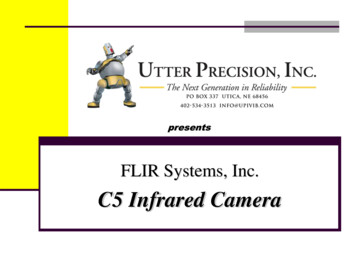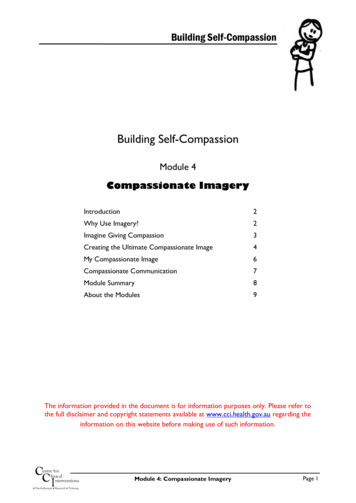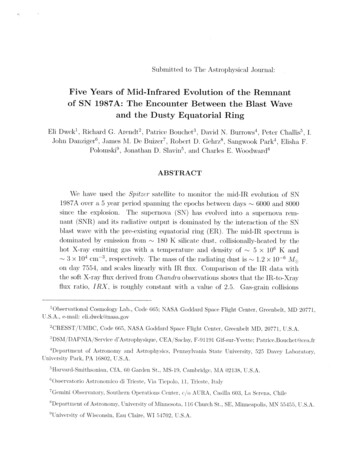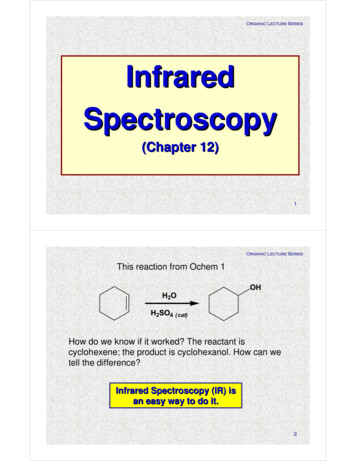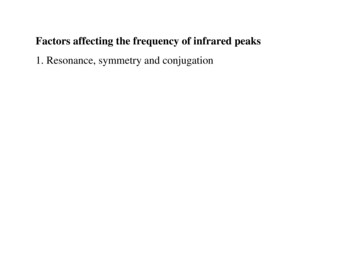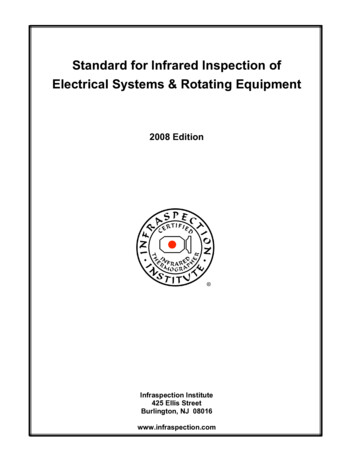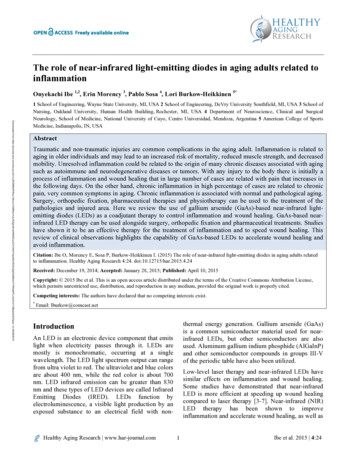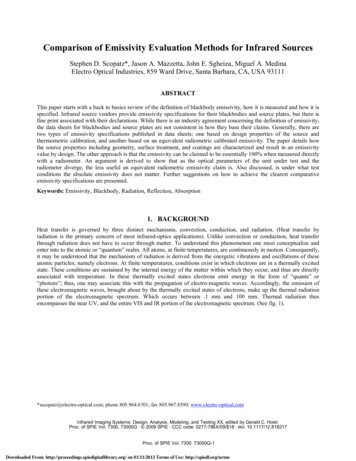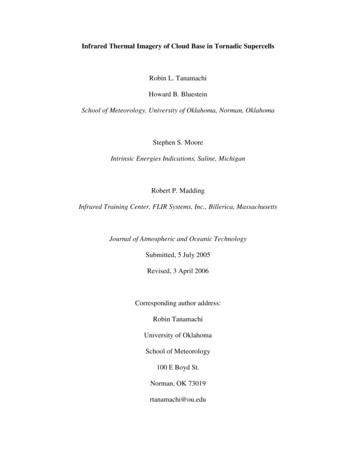
Transcription
Infrared Thermal Imagery of Cloud Base in Tornadic SupercellsRobin L. TanamachiHoward B. BluesteinSchool of Meteorology, University of Oklahoma, Norman, OklahomaStephen S. MooreIntrinsic Energies Indications, Saline, MichiganRobert P. MaddingInfrared Training Center, FLIR Systems, Inc., Billerica, MassachusettsJournal of Atmospheric and Oceanic TechnologySubmitted, 5 July 2005Revised, 3 April 2006Corresponding author address:Robin TanamachiUniversity of OklahomaSchool of Meteorology100 E Boyd St.Norman, OK 73019rtanamachi@ou.edu
ABSTRACTDuring the spring seasons of 2003 and 2004, an infrared thermal camera wasdeployed in and around supercell thunderstorms in an attempt to retrieve temperature atthe cloud base of a mesocyclone prior to tornadogenesis. The motivation for this exercisewas to obtain temperature information that might indicate the thermal structure, timingand extent of the rear-flank downdraft (RFD) and possibly elucidate its relationship totornadogenesis.An atmospheric transmissivity study was conducted to account for the effects ofatmospheric transmission on the measured temperatures, and to determine an ideal rangeof distances from which infrared images of a wall cloud or a tornado could be safelycaptured while still retrieving accurate cloud temperatures. This range was found to be1.5 to 3 km.Two case days are highlighted in which the infrared camera was deployed within1.5 to 3 km of a tornado; the visible and infrared images are shown side-by-side forcomparison. On the single occasion on which the tornadogenesis phase was captured, theinfrared images show no strong horizontal temperature gradients. From the infraredimages taken of tornadoes, it can be inferred that the infrared signal from the tornadoconsisted primarily of infrared emissions from lofted dust particles or cloud droplets, andthat the infrared signal from the tornado condensation funnel was easily obscured byinfrared emissions from lofted dust particles or intervening precipitation curtains.The deployment of the infrared camera near supercell thunderstorms and theanalysis of the resulting images proved challenging. It is concluded that the infraredcamera is a useful tool for measuring cloud base temperature gradients provided that1
distance and viewing angle constraints are met and that the cloud base is unobscured byrain or other intervening infrared emission sources. When these restrictions were met, theinfrared camera successfully retrieved horizontal temperature gradients along cloud baseand vertical temperature gradients (close to the moist adiabatic lapse rate) along thetornado funnel.2
1.INTRODUCTIONCloud base characteristics are determined by the thermodynamic and air flowcharacteristics of the air in which the clouds form. In a supercell thunderstorm, variationsin the height of the cloud base, which can be relatively sharp, can indicate distinctthermodynamic and air flow characteristics of adjacent air masses.Tornado formation in supercell thunderstorms is frequently observed near theupdraft-downdraft interface in a “divided” mesocyclone (Fig. 1; Lemon and Doswell1979; Doswell 1985). It has been suggested that the temperature field in and near a lowlevel mesocyclone, particularly that associated with the rear-flank downdraft (RFD), mayplay a role in tornadogenesis (Davies-Jones et al. 2001; Markowski et al. 2002). Previousfield studies tested this hypothesis using mobile in situ instruments to measurethermodynamic variables in and around the tornado’s parent mesocyclone. While thecollection of mobile in situ data was often successful, the usefulness of the data wassomewhat limited by the confinement of most of the measuring instruments to the levelnearest the surface, which resulted in 1D or quasi-2D measurements. Comprehensivesummaries of these study efforts can be found in Markowski (2002a) and Bluestein(1999). It is currently thought that the relationship between the RFD and tornadogenesisremains, at best, “confusing” (Markowski 2002a), the same conclusion reached byDoswell (1985).RFDs are herein defined as “regions of subsiding air that develop on the rear[with respect to storm motion] side of the main updraft of supercell storms” (Markowski2002a). An RFD is often visually manifest as a “dry intrusion” or “clear slot” in the baseof a supercell (Fig. 2), which results from evaporation of cloud droplets in the air that is3
advected downward and which usually has a relatively low wet-bulb potentialtemperature ( w). The appearance of a clear slot has frequently been observed to precedethe appearance of a tornado by a few minutes. Upon reaching the surface, the air in theRFD spreads out horizontally. The leading edge of this air is called a “rear-flank gustfront,” and it is usually marked by a shift in wind direction at the surface. This shift inwind direction depends upon the location of the observer and the life cycle stage of themesocyclone. An observer located south of the mesocyclone will usually experience awind shift from southeasterly (easterly) to northerly or northwesterly (southerly) in thevicinity of a mature (occluded) mesocyclone. Observations collected within supercellstorms indicate that the air behind the rear-flank gust front may be significantly colder(e.g., Dowell and Bluestein 1997), the same temperature, or even warmer (e.g., Bluestein1983) than the air ahead of it.It has been hypothesized that the absence of a temperature (and hence, buoyancy)gradient across the rear-flank gust front may be a necessary but not sufficient conditionfor the formation of significant tornadoes (Markowski et al. 2002). Markowski(2002a)reviewed numerical simulations of supercell thunderstorms, and remarked that thesesimulations consistently produced “cool” RFDs, even though “warm” or “neutral” RFDsare sometimes observed in nature. It was suggested that the microphysicsparameterizations in the numerical models were responsible for this unrealisticcharacteristic. For this reason, an observational approach to evaluating the temperaturegradients along the cloud base in supercell thunderstorms has been favored overnumerical simulations.4
It is also important to consider the origin of air parcels entering the cloud base nearwhere tornadoes form. In Fig. 1, it is seen that air in the updraft may come from the RFD,from the environment ahead of the storm, or from the forward-flank downdraft (FFD).The height of the cloud base and its temperature can yield information about where theair entering into it originated. For example, Rotunno and Klemp (1985) showed howcooler, more humid air from the FFD entering the updraft base can produce a loweredcloud base, the wall cloud. Variations in temperature and height of the cloud baseassociated with the updraft may yield clues as to where the air came from.One of the factors limiting previous observational studies in supercells has beensafety; the safe deployment of thermodynamic measuring instruments in a dense networkclose to a tornadic mesocyclone is extremely difficult. Another limitation has been therelative scarcity of above-surface 2D and 3D thermodynamic observations in this region;observational studies conducted during VORTEX and other field experiments have beenlargely limited to 1D and quasi-2D surface observations (e.g., Markowski et al. 2002).The following study was motivated by the desire to address these two limitations.Infrared thermal imagery, or thermography, can be used to infer the temperatureof objects from the images of their emitted long wave infrared radiances. Infrared thermalimagery is familiar to the general public through its industrial, military, and lawenforcement applications (Holst 2000; Burnay et al. 1988). Infrared thermal imagery hasbeen used extensively in meteorological applications involving satellite infrared thermalimagers (Kidder and Vonder Haar 1995; Burnay et al. 1988; Liou 2002) and groundbased, skyward-pointing atmospheric infrared detectors (e.g., Knuteson et al. 2004), both5
of which are designed primarily for the purpose of deducing the thermal structure of theatmosphere as a function of altitude over a point on the earth’s surface.In this study, a digital infrared camera was used in an attempt to distinguishamong different stages in the life cycle of a tornado based on the measured thermalcharacteristics of the visible tornado and surrounding cloud base. This study marks thefirst known use (to the best knowledge of the authors) of ground-based digital infraredthermography for severe storms research.In order to determine what type of temperature gradients we might anticipatemeasuring along a tornadic supercell cloud base, the temperature and cloud water mixingratio fields of a numerically simulated tornadic supercell (M. Xue, personalcommunication) were examined. Qualitatively, the structure of the temperature field atthe cloud base of the numerically simulated supercell was roughly representative of thestructure of the temperature field at the surface. From the results of these and othersimulations (e.g., Rotunno and Klemp 1985), it was inferred that temperature gradientson the order of 5 C km-1 or less could potentially be anticipated along a cloud base in thevicinity of a tornado.In effect, it was assumed in this study that the cloud base temperature field wasqualitatively representative of the temperature field at the surface. The validity of thisassumption remains an open question and its evaluation is beyond the scope of this study.To determine the extent cloud-base temperatures would actually be useful in estimatinghorizontal temperature gradients at the surface and thus to be able estimate the rate ofbaroclinic generation of horizontal vorticity, 3D, in situ measurements would be required6
and/or an extensive set of high-resolution numerical experiments would need to beconducted.The infrared camera was deployed near numerous supercell thunderstorms in2003 and 2004 (Fig. 3). The infrared camera used was a tripod-mounted, digital, FLIRSystems brand S60 ThermaCam digital radiometric imager (Fig. 4) capable of detectinginfrared radiation in wavelengths between 8 and 12 m at a resolution of 320 240pixels. The 8 – 12m band is a water vapor “window,” wherein water vapor hasrelatively low emissivity and absorptivity, and therefore a relatively small effect onatmospheric transmissivity. As will be discussed later, the use of this wavelength bandposed difficulties. The infrared camera and its software were designed primarily for theexamination of solid objects at close range, while minimizing the effects of emissionsfrom the intervening air. An RFD itself could not be imaged, as it would be composedmostly of clear air. Air temperatures had to be inferred from the temperatures of infraredemitters that were present in the air nearby (cloud droplets, dust, etc.).The infrared camera was also equipped with a low-resolution (640 480 pixels)digital camera, enabling the thermographer to capture a corresponding visible imagewithin a few seconds of the infrared image capture. Side-by-side analysis of the visibleand infrared images was therefore possible.Section 2 details the atmospheric transmissivity issues related to this study. InSection 3, two cases are highlighted in which side-by-side visible and infrared thermalimages of tornadoes and their attendant cloud bases are examined. In Section 4,interpretations and conclusions are presented.2.ATMOSPHERIC TRANSMISSIVITY STUDY7
An atmospheric transmissivity study was conducted to determine the effect ofatmospheric attenuation on the infrared signal from cloud base. Infrared thermal imageswere captured of low-level, cumuliform, non-precipitating water clouds above theNational Weather Service (NWS) office in Norman, Oklahoma. These images werecaptured at the same time as standard NWS 00 UTC rawinsonde launches. Cloud-basetemperatures measured by the infrared camera were then compared with the loweratmospheric profile measured by the rawinsonde.Clouds composed of water droplets and of sufficient thickness to be classified asopaque generally behave like blackbodies (Liou 2002); a cloud emissivity of 0.98 (thedefault setting of the infrared camera) was assumed. The present transmissivity studymade use of the assumption that (1) the cloud base height was the same as the liftingcondensation level (LCL) height calculated for a parcel representative of the meanmeasurements collected in the lowest 500 m of the atmosphere by the rawinsonde, and(2) the temperature of the cloud droplets in the cloud base was the same as thecorresponding calculated LCL temperature. The errors in the LCL height ( 50 m; Cravenet al. 2002) and LCL temperature ( 0.5 K at 800 mb) calculated from the rawinsondemeasurements were assumed to be negligible for the purposes of this study. The smallamount of heating caused by latent heat release from condensation (Wallace and Hobbs1977) was also assumed to be negligible since the temperature change due to this heatingprobably occurred at a slow rate during cloud formation, falling within the range ofspectral noise of the infrared camera ( 2 C).The approximate line-of-sight distance from the infrared camera to a selectedcloud base was computed from the elevation angle of the camera using simple8
trigonometry, and the height of the LCL was computed from the rawinsondeobservations. The computed line-of-sight distance and known ambient atmosphericconditions were entered into proprietary ThermaCam software designed to correct themeasured temperatures in the images for clear-air atmospheric attenuation by watervapor, using a simplified version of the MODTRAN radiative transfer model (Berk et al.1989). The atmospheric attentuation of the intervening air was approximated using themeasured relative humidity of the ambient atmosphere and an empirically-fit cubicfunction of the measured ambient atmospheric temperature.The limitations of this simplified model became apparent when the “corrected”temperature of the cloud base as measured by the infrared camera was compared with theLCL temperature calculated from the rawinsonde measurements. The three primarycauses of erroneous temperature readings in the atmospheric transmissivity study were asfollows: (1) infrared-emitting constituents (such as haze and ozone) in the planetaryboundary layer contaminated cloud temperature measurements at low elevation angles,causing the measured temperatures of cloud base at these low elevation angles to be toowarm. (2) All objects in a given infrared image were assumed by the camera software tobe at the same distance from the infrared camera. If the distance setting of the infraredcamera was too large, the camera software overcompensated for atmospheric attenuation,and the cloud appeared to be too warm. If the distance setting was too small, the camerasoftware undercompensated for atmospheric attenuation, and the cloud appeared to be toocold. (3) If the cloud was not optically thick, or there were breaks in the clouds, the coldupper troposphere or colder or more distant clouds were “visible” through the cloud in9
the infrared, and the cloud appeared to be too cold. These sources of cloud basetemperature measurement error are depicted in Fig. 5.In the present study, the proprietary ThermaCam software correction compensatedwell for the erroneous camera settings, but not as well for the optically thin clouds or forthe infrared emissions from boundary layer gases and particles. An apparent positivecorrelation between the concentration of infrared emitters (such as haze) in the lowestlevels of the troposphere and the air temperature near the surface was observed, implyingthat the error source described in Fig. 5a would have a greater effect at higher surface airtemperatures.As the camera was tilted towards the horizon, the optical depth of the interveningatmosphere decreased owing to the relatively high concentrations of water vapor, ozone,and other infrared-emitting gases and particulates in the planetary boundary layer. Justabove the horizon, the infrared signal from the distant cloud base became entirelyobscured by these nearer infrared emission sources (Fig. 6). Thus, the measuredtemperatures of clouds near the horizon were unrealistically high. In general, low cloudsappeared warmer than their surroundings when the camera elevation angle was greaterthan 30 , owing to their contrast against cooler upper tropospheric air or colder clouds athigher elevations.The data used in the transmissivity study are plotted in Fig. 7. The differencebetween the “corrected” temperature of the cloud base as measured by the infraredcamera and the rawinsonde became more negative as the distance of the cloud base fromthe infrared camera increased. At the shortest distances (less than 1.5 km) thetemperatures measured by the infrared camera, which were inferred from infrared images10
collected while the camera was pointing straight up, were much cooler than thoserecorded by the rawinsonde. This error probably resulted from contamination of the cloudtemperature measurement by the clear sky above, i.e., the clouds were not optically thickenough to completely obscure the infrared signal from the cold upper troposphere.Thunderstorm clouds are optically very thick, and so this potential source of temperaturemeasurement error was not considered in the study of tornadic supercells discussed in thenext section.The shaded box in Fig. 7 encloses a region that represents an optimum distancefor temperature measurement between the camera and the cloud base, betweenapproximately 1500 and 3000 m (1.5 and 3.0 km). In this region, the difference betweenthe temperature measured by the rawinsonde and that measured by the infrared camerawas most consistently close to zero; thus, it is reasonable to suggest that 1.5 to 3.0 km isthe best range from which to study temperature changes accurately (and, in the case ofmesocyclones, safely) across low cloud bases. This finding agrees to some extent withthat of Holst (1996), who found that atmospheric transmissivity decreases markedly inthe 8-12 m band at ranges between 2 and 5 km.Even within this “best range” of 1.5 to 3.0 km, errors of up to 4 C were stillpresent. Changes in air temperature of even a few degrees can significantly impactthunderstorm dynamics. Therefore, the primary focus of the next section will be on themeasured gradients of temperature along the cloud base in tornadic thunderstorms, ratherthan on the temperature measurements themselves.3.INFRARED THERMAL IMAGERY IN TORNADOES11
During the spring seasons of 2003 and 2004, the infrared camera was deployednear supercell thunderstorms (e.g., Fig. 3). The goal of each infrared camera deploymentwas the capture of infrared images within 3 km of a wall cloud associated with a tornadicmesocyclone. The 3 km distance criterion, derived from the transmissivity studydescribed in the previous section, was intended to ensure that the camera would be closeenough to distinguish the infrared signal of the cloud base from that of the interveningatmosphere. There were nine deployments in 2003 and 16 deployments in 2004. Thedeployments occurred alongside a mobile radar unit (e.g., Kramar et al. 2005; Bluesteinet al. 2004; Wurman and Gill 2000) whenever possible, in order to ascertain an accurateline-of-sight distance between the infrared camera and developing tornadoes. Whatfollows is discussion of the two most successful case days and the infrared imagescaptured on each.a.12 May 2004: Harper Co., KansasOn 12 May 2004 (local time), a storm intercept team from the University ofOklahoma (OU) documented at least seven tornadoes in a supercell thunderstorm thatoccurred over Harper County, Kansas. The National Weather Service office in Wichita,Kansas documented eleven separate tornadoes in this supercell (Hayes 2004). Over 100infrared images of tornadoes and their associated cloud base prior to tornadogenesis werecaptured in t
An atmospheric transmissivity study was conducted to account for the effects of atmospheric transmission on the measured temperatures, and to determine an ideal range of distances from which infrared images of a wall cloud or a tornado could be safely captured while still retrievin
